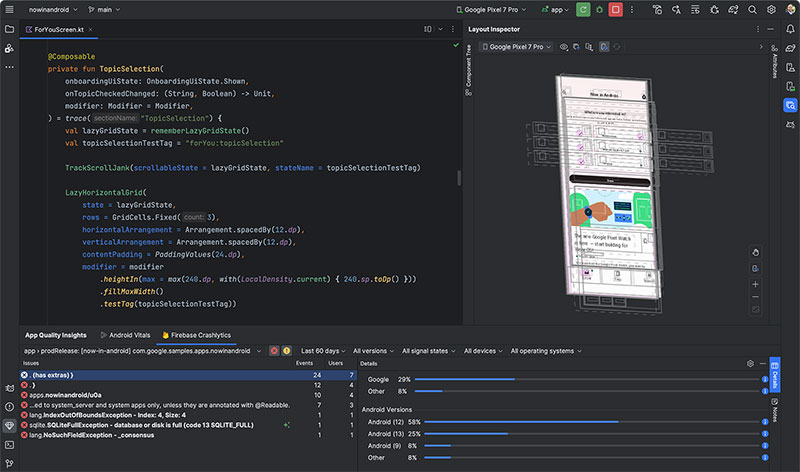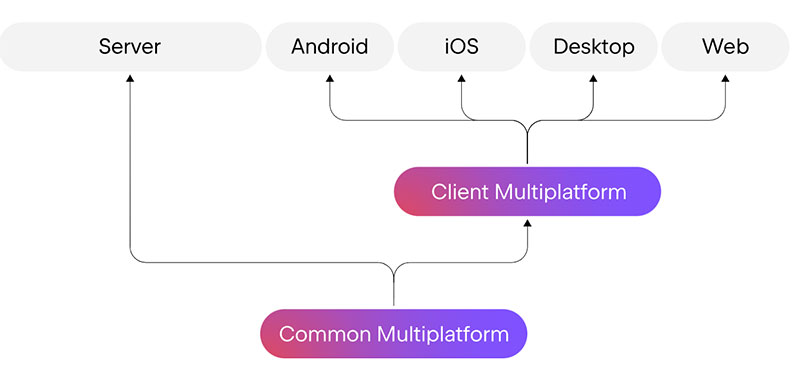Kotlin’s Key Uses: What is Kotlin Used For?

Imagine harnessing a language that elegantly treads the tightrope of modernity and functionality. Kotlin, a name that whispers through the corridors of Android app development, has silently revolutionized how code breathes life into our most beloved mobile companions.
In the digital tapestry where Java once reigned unchallenged, Kotlin emerges as a vibrant thread, weaving through JVM languages with its interoperable and concise syntax. Its battlefield prowess extends beyond Android; Kotlin’s resilience shines in server-side applications and cross-platform coding.
Through this reading journey, unravel the myriad uses of Kotlin, from crafting intuitive Android applications to piloting Kotlin Multiplatform projects.
With each paragraph, add to your coding arsenal the knowledge of why Google endorses Kotlin, and how it transcends the Java legacy with null safety and coroutines.
Embark on uncovering the scope of Kotlin—demystified, digested, and served for the curious mind. By the article’s end, not only will “What is Kotlin used for?” be a question of the past, but the foresight of its potential uses will be a beacon guiding your future projects.
What is Kotlin Used For?
Kotlin is primarily used for Android app development, providing a modern, concise alternative to Java with full interoperability. It’s also employed in backend development, web applications, and desktop applications. Kotlin offers features that improve code safety and clarity, making it popular among developers for cross-platform development.
| Use Case | Features | Tools/Libraries | Scalability | Representative Apps |
|---|---|---|---|---|
| Android Apps | Modern, succinct | Android Studio, Anko | Gradle build system | Trello, Pinterest |
| Server-side | JVM integration | Ktor, Spring Boot | Microservices support | CORDA, Atlassian tools |
| Web Frontend | Transpiles to JS | React, Vue.js (with Kotlin/JS) | SPA frameworks | JetBrains Space |
| Cross-platform | Shared codebase | Kotlin Multiplatform | Reusable modules | KotlinConf App |
| Data Science | Data processing | kotlinx.serialization, kmath | JVM performance | Zeppelin Kotlin kernel |
Advantages of Kotlin

Kotlin, right? It’s like the cool kid on the block in the world of programming languages.
So, what is Kotlin used for, you ask? It’s not just about writing code; it’s about writing it better, faster, and smarter. Let’s break down why Kotlin is winning hearts and minds in the tech world.
Conciseness and Efficiency
Reduction of Boilerplate Code
Ever get tired of writing the same old code over and over? Kotlin steps in to cut that down.
Less code means fewer chances for errors, and who doesn’t love that? It’s like having a super-efficient assistant who takes care of the mundane stuff, leaving you free to focus on the creative part.
Enhanced Readability and Maintainability
Kotlin isn’t just concise; it’s like poetry. The code is so clean and understandable, it almost reads like a story.
This makes maintaining and updating your code as breezy as a walk in the park. It’s like Kotlin has its own way of saying, “I got you!”
Safety and Reliability
Null Safety Features
Null references? More like nightmare references, am I right? Kotlin’s null safety feature is a game-changer.
It’s like having a guard that stops you from accidentally walking into coding pitfalls. Safety first, always!
Reduction of Common Coding Errors
Imagine a world with fewer coding errors. That’s the world Kotlin is building. By handling common mistakes in its design, Kotlin keeps your code not just running, but running smoothly.
It’s like having an invisible coding mentor, always guiding you away from potential errors.
Interoperability and Compatibility
Seamless Integration with Java
Here’s a big one: Kotlin works hand in hand with Java. It’s like they’re best buddies in the coding playground.
You can use all your favorite Java libraries and frameworks without missing a beat. Check out this link for more insights on the best IDEs for Android, which often include support for both Kotlin and Java.
Access to Java Frameworks and Libraries
Kotlin’s like your all-access pass to the vast world of Java frameworks and libraries.
It’s like having a VIP ticket to the best coding resources out there.
Community and Support
Growing Developer Community
The Kotlin community is like this ever-expanding universe of knowledge and support.
Whether you’re a newbie or a seasoned pro, there’s always something new to learn and someone ready to help.
Continuous Language Improvement and Support
Kotlin isn’t just sitting pretty; it’s always evolving. Continuous improvements mean it’s always getting better, stronger, and more capable.
It’s like watching your favorite app get cool new updates, but it’s your programming language.
Applications of Kotlin
Android Development
Preferred Language for Android App Development
Picture this: You’re crafting an app, and you want it to be sleek, efficient, and crash-proof. That’s where Kotlin comes in.
It’s like the secret sauce for Android apps. Google itself gave it a thumbs up as the preferred language for Android. Kotlin makes life easier for app developers, like having a magic wand that turns complex code into something manageable.
Full Support in Android Studio IDE

Kotlin and Android Studio are like best friends. They just get each other. Android Studio fully supports Kotlin, meaning you get all the cool tools and features to make your app-building journey as smooth as a silk road.
It’s like having a high-tech lab to bring your app ideas to life.
Server-Side and Back-End Web Development
Use in JVM and Kotlin/JS for Server-Side Development
Think of server-side development as the backbone of a website. Kotlin, with its compatibility with JVM (Java Virtual Machine), makes it a powerhouse for back-end development.
It’s like having a super fuel for your server’s engine. Plus, with Kotlin/JS, you get to extend your prowess to JavaScript environments. Pretty versatile, right?
Integration with Frameworks like Spring
Frameworks are like the building blocks for web apps, and Kotlin fits perfectly with giants like Spring.
This integration makes building robust and scalable server-side applications more intuitive. It’s like having a toolkit that fits perfectly in your development puzzle.
Full-Stack Web Development
Kotlin/JS for Front-End Development
Now, let’s not forget the front-end, the face of your website. Kotlin steps up here too with Kotlin/JS.
It helps in crafting interactive and dynamic web pages. Imagine blending Kotlin’s power with the finesse of JavaScript; it’s like having the best of both worlds in your coding arsenal.
Consistent Syntax and Libraries for Both Front-End and Back-End
Kotlin offers this unique advantage of consistent syntax for both front-end and back-end development.
It’s like learning one language and speaking in many. This consistency streamlines the development process, making it smoother than a hot knife through butter.
Cross-Platform Mobile Development
Kotlin Multiplatform Mobile (KMM) for iOS and Android

Ever dreamt of writing code once and running it on both iOS and Android? Enter Kotlin Multiplatform Mobile (KMM).
It’s like a coding chameleon, adapting to different mobile platforms with ease. This means more reach with less hassle – a dream come true for app developers.
Native Capabilities and Simplified Development Process
Kotlin brings native capabilities to the table, meaning your apps feel right at home on whatever device they’re on.
Plus, the development process is simplified, like having a smooth, straight road instead of a bumpy, winding path.
Data Science
Compatibility with Java Libraries
In data science, the more tools you have, the better. Kotlin is compatible with Java libraries, which is like having an extended family of resources at your disposal.
This compatibility opens up a world of possibilities in data analysis and processing.
Use in Data Visualization and Research Tools
Imagine transforming complex data into something visually stunning and insightful.
That’s what Kotlin can help with in data visualization and research tools. It’s like being an artist and a scientist at the same time.
Kotlin vs. Java
Ah, the classic showdown: Kotlin vs. Java. It’s like comparing a sleek, new electric car with a reliable, classic sedan.
Both have their charms, right? So, let’s dive into this comparison and see why what Kotlin is used for might differ from Java’s path.
Comparative Analysis
Differences in Syntax and Code Structure
Kotlin is like the cool younger sibling of Java, known for its concise and expressive syntax.
It cuts down on the boilerplate, you know, the repetitive, tedious stuff in coding. Java, while powerful, can feel a bit like running a marathon with extra weights – it gets the job done but requires more effort.
Efficiency and Performance Aspects
Talking about efficiency, Kotlin steps up with features like coroutines for asynchronous tasks. Java is no slouch either, with its time-tested performance and optimization.
But Kotlin brings a fresh approach, like adding turbo boost to your code’s engine.
Transition and Learning Curve
Ease of Transition for Java Developers
If you’re already a Java pro, switching to Kotlin is like learning to drive a different model of the same car brand.
You’ll find familiar controls with some new, fancy buttons. Thanks to Kotlin’s interoperability with Java, the transition is smoother than a new coat of paint.
Learning Resources and Community Support
No matter where you’re starting, there’s a wealth of resources out there. Kotlin’s growing community and support make learning an adventure.
Think of it as having a GPS with multiple routes; you can choose your path and pace. For insights into the best IDEs supporting both Java and Kotlin, check out this handy guide.
FAQ On What Kotlin Is Used For
Is Kotlin exclusively for Android development?
Absolutely not. Kotlin steps beyond the Android landscape with its cross-platform superpowers. You’ll see it in server-side systems, web applications via Kotlin/JS, and even iOS development owing to Kotlin Multiplatform. Flexibility is Kotlin’s middle name.
How does Kotlin interact with Java code?
Like a master key, Kotlin unlocks seamless compatibility with Java. They coexist within the same project, allowing interoperation. Kotlin can call upon Java code and vice versa, offering a smooth transition for those dancing away from Java’s embrace.
Can you use Kotlin for backend development?
Kotlin for server-side is a reality, not a dream. With frameworks like Ktor or Spring Boot, this versatile language has made significant inroads, allowing developers to craft robust backend services with the poise and type safety Kotlin is revered for.
What are the data classes in Kotlin for?
Simplicity and clarity adorn Kotlin’s data classes. Designed to hold data without the boilerplate, these classes automatically equip with useful functions like equals(), hashCode(), and toString(), making them ideal for models in your applications.
How do Kotlin coroutines enhance app development?
Efficiency meets elegance with Kotlin coroutines. These tackle asynchronous tasks without the jarring complexity, smoothing over threading concerns with a more readable “sequential” style that minds the user experience without blocking threads.
What role does Kotlin play in cross-platform development?
Forefront and center. Kotlin Multiplatform is a beacon in the realm of cross-platform coding, sharing logic across platforms while keeping the UI native. Simplify your life; write once, and target iOS, Android, or even the web.
Is Kotlin only suitable for large-scale applications?
Kotlin does not discriminate by size. It thrives within the grand tapestry of vast, complex systems, and yet, it fits comfortably in the simplicity of small scripts or minor modules. Kotlin adapts, whether it’s a colossal enterprise application or a diminutive utility.
Does Kotlin offer null safety?
Indeed, it’s among Kotlin’s selling points. Kotlin’s type system is designed to eradicate the dread of NullPointerException. By distinguishing nullable and non-nullable types, it enforces safer code practically begging you to heed its cautions, for a null check skipped is a bug’s refuge.
Does Google officially support Kotlin?
Google, in a moment of clairvoyance, embraced Kotlin. Announced at Google I/O, the language has garnered official support as the preferred choice for Android apps. Google’s endorsement is a strong sign of Kotlin’s standing in the mobile development echelon.
How easy is it to learn Kotlin for a Java developer?
Transforming from a Java developer to Kotlin connoisseur is less a leap and more a graceful stride. The syntax might be succinct, yet it’s intuitive. Java’s familiarity bridges you toward Kotlin’s modern features. JetBrains’ IntelliJ IDEA stands by, easing the transition with robust tooling.
Conclusion
In the dance of digital dialects, what is Kotlin used for pivots as a leading question met by a symphony of answers. Pausing at the finale of this discourse, the melody of Kotlin’s capabilities resonates clear and profound.
- It’s the whisper behind innovative Android apps that seamlessly integrate with the Google ecosystem.
- A vibrant stroke in cross-platform frameworks painting versatility across iOS and web canvases.
- A secret ingredient in server-side applications, brewing robustness in the backend with an infusion of Ktor or Spring Boot.
This language, once cradled in the chambers of JetBrains, now strides confidently across the plains of code, devoid of the shackles of platform or scale. From crafting the minutiae of data classes to orchestrating the grandeur of Kotlin Multiplatform ventures, Kotlin has underscored its role as a torchbearer of modern programming.
Curtains close. Kotlin stands—a quiet sentinel, promising a future crafted with code that’s as resilient as it is elegant.
- Exploring Beyond Java: Top JVM Languages to Learn - May 18, 2024
- Explore Knowledge: Community Q&A Apps Like Quora - May 17, 2024
- Verifying Digital Ads Using Residential Proxies to Avoid Fraud - May 17, 2024








